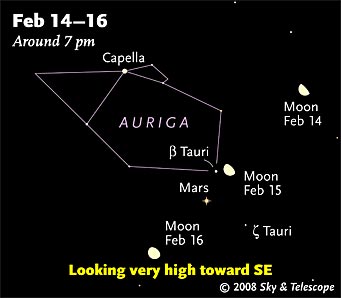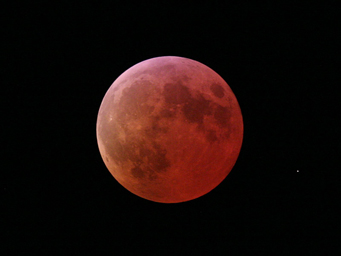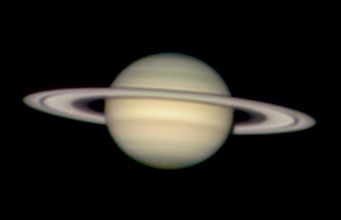Some daily events in the changing sky for February 8 – 16.

The waxing Moon will shine near Mars and especially Beta (β) Tauri on the evening of February 15th, while Capella looks on. This view is drawn for the middle of North America. European observers: move each Moon symbol a quarter of the way toward the one for the previous date.
Sky & Telescope diagram
Friday, February 8
Saturday, February 9
Sunday, February 10
Monday, February 11
Tuesday, February 12
Wednesday, February 13
Thursday, February 14
Friday, February 15
Saturday, February 16

A preview of the Moon on the 20th? The total lunar eclipse of March 3-4, 2007, was a relatively bright one. S&T editor Rick Fienberg captured this view from Garching, Germany, where he was attending a planning meeting for the International Year of Astronomy 2009. Click image for larger view.
S&T: Rick Fienberg
Want to become a better amateur astronomer? Learn your way around the constellations. They're the key to locating everything fainter and deeper to hunt with binoculars or a telescope. For an easy-to-use constellation guide covering the whole evening sky, use the big monthly foldout map in each issue of Sky & Telescope, the essential magazine of astronomy. Or download our free Getting Started in Astronomy booklet (which only has bimonthly maps).
Once you get a telescope, to put it to good use you'll need a detailed, large-scale sky atlas (set of maps; the standard is Sky Atlas 2000.0) and good deep-sky guidebooks (such as Sky Atlas 2000.0 Companion by Strong and Sinnott, the even more detailed Night Sky Observer's Guide by Kepple and Sanner, or the enchanting though increasingly dated Burnham's Celestial Handbook). Read how to use them effectively.
More beginners' tips: "How to Start Right in Astronomy".
This Week's Planet Roundup
Mercury is hidden in the glow of the sunrise.
Venus (magnitude –3.9, in Sagittarius) is getting lower every morning. Look for it above the southeast horizon about 30 or 40 minutes before sunrise, to the lower left of Jupiter. On Friday morning the 8th Venus and Jupiter are still only 7° apart, but by Saturday the 16th they draw to 15° apart.
Mars (about magnitude –0.3, in eastern Taurus) shines very high in the south during evening, high above Orion. The fairly bright star near it is Beta (β) Tauri, also known as El Nath, magnitude +1.6 and pale blue-white. Mars is just about in the center of the big quadrilateral formed by Capella, Aldebaran, Betelgeuse, and the Pollux-Castor pair.
In a telescope, Mars diminishes from 11.1 to 10.3 arcseconds in apparent diameter this week. See the observing guide and surface-feature map in the November Sky & Telescope, page 66, or the short version online.
Jupiter is getting easier to see low in the southeast during early dawn. It's moving farther to the upper right of Venus by 1° per day.

Saturn's rings are currently tilted only 8° to our line of sight. Sean Walker took this fine image at the Winter Star Party in the Florida Keys on the night of February 7–8, using Don Parker's Takahashi Mewlon 250 (10-inch) DK telescope in strong winds. Note the dusky C ring just inside the broad, bright B ring. The C ring is obvious as a dark silhouette where it crosses in front of the globe. Just beyond the rings' outer edge, their shadow on the globe forms a thin black line. The globe's shadow on the rings is seen just beyond the limb at lower right.
S&T: Sean Walker
Saturn (magnitude +0.3, in Leo) is nearly at opposition. It rises in the east in late dusk and stands highest in the south around midnight. Fainter Regulus (magnitude +1.4) is 6° west of Saturn: to its upper right after they rise. Only a little dimmer than Regulus is Gamma (γ) Leonis (magnitude +2.1), located 8° to Regulus's north. The three make an eye-catching triangle.
Uranus and Neptune are lost in the glow of sunset.
Pluto (magnitude 14.0, in Sagittarius) is low in the southeast before the first light of dawn.
All descriptions that relate to your horizon or zenith — including the words up, down, right, and left — are written for the world's midnorthern latitudes. Descriptions that also depend on longitude (mainly Moon positions) are for North America. Eastern Standard Time (EST) equals Universal Time (UT, UTC, or GMT) minus 5 hours.
To be sure you always get the current Sky at a Glance, bookmark this URL:
http://SkyandTelescope.com/observing/ataglance?1=1
If pictures fail to load, refresh the page.
 0
0
Comments
You must be logged in to post a comment.